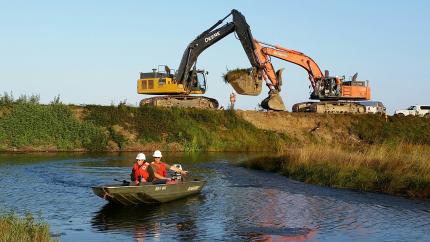
The Washington Department of Fish and Wildlife administers or assists with a number of programs to protect and preserve habitat in the state, whether responding to emergencies or proactively aiding fish and wildlife species faced with a changing environment.
-
Habitat engineering
WDFW's habitat engineering team provides support and input for habitat restoration and construction projects across Washington.
-
Find a WDFW habitat biologist
Find contact information for a WDFW habitat biologist in your area with this interactive webmap.
-
Fish Passage
When salmon and steelhead cannot migrate upstream to spawn due to stream and river barriers, populations decline. WDFW works to correct these barriers in Washington.
-
Priority Habitats and Species (PHS) Program
This program shares information about the locations of fish, wildlife, and their habitats, to inform local governments, landowners, and others.
-
Land Use Conservation and Policy (LUCP)
WDFW’s Land Use Conservation and Policy (LUCP) section promotes fish, wildlife, and habitat conservation priorities via land-use planning under the Growth Management Act and Shoreline Management Act.
-
Puget Sound recovery
WDFW works to protect and restore Puget Sound shoreline and nearshore environments such as beaches, bluffs, inlets, and river deltas.
-
Oil spill prevention and response
WDFW's Oil Spill Team is dedicated to rescuing oiled wildlife and protecting natural resources.
-
Farm Bill programs in Washington
The federal Farm Bill delivers many benefits to fish, wildlife, and their habitats in Washington, as well as local landowners.
-
Chehalis Basin Strategy
The basin-wide strategy includes actions and projects designed to reduce flood-related damage while also restoring aquatic species habitat in the Chehalis River basin.
-
Columbia River hydropower system
There are numerous dams throughout the Columbia River basin that have impacts on fish and wildlife species, including ESA-listed salmon and steelhead.
-
Habitat connectivity
See how WDFW and partners are working to protect and improve habitat connectivity for Washington's wildlife.
-
Washington Shrubsteppe Restoration and Resiliency Initiative
The Washington Shrubsteppe Restoration and Resiliency Initiative (WSRRI) benefits wildlife by restoring shrubsteppe habitat, helping at-risk species recover, and supporting working lands in Eastern Washington.
-
Stillaguamish Restoration and Recovery
A relatively small river with a huge impact, the Stillaguamish is at the leading edge of salmon declines and habitat conservation concerns in Washington state and across the West Coast.
-
High Resolution Change Detection (HRCD) project
Explore how land cover – specifically new development and/or tree loss – has changed over time using high resolution aerial imagery.
-
Derelict fishing gear removal project
Derelict fishing gear includes nets, lines, crab and shrimp traps or pots, and other equipment lost or abandoned in the marine environment.
-
Volunteer Cooperative Grant Program
The Aquatic Lands Enhancement Account Program has supported hundreds of projects that engage volunteers and benefit Washington’s fish and wildlife resources.
-
SalmonScape
The SalmonScape mapping tool shows how streams are used by the five Pacific salmon species in the state.